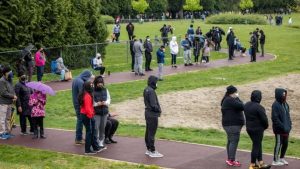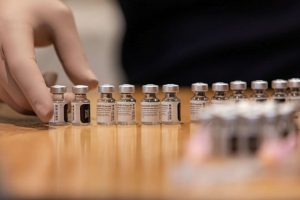Canada now among top countries for 1st doses of COVID-19 vaccines. So how high can we go?

After lagging behind other countries in the early months of vaccination, Canada is now among the leaders when it comes to the percentage of the population vaccinated against COVID-19 with at least one dose.
Freeland to attend in-person G7 finance ministers meeting in London
So far, Canada has vaccinated 58 per cent of the total population with at least one dose, putting the country just behind Israel, which has plateaued at around 63 per cent of its population, and roughly neck-and-neck with the U.K.
That means Canada is among the highest ranks of other large countries, and not far behind the global front-runner for first dose — an island nation in the Indian Ocean.
Seychelles has already hit more than 70 per cent of the country being vaccinated — though it’s worth noting that country only has a population of around 97,000. It primarily used the Sinopharm vaccine developed in China, which hasn’t been approved for use in Canada.
The United States, which is also aiming for a 70 per cent vaccine coverage by July 4, is now seeing an increase in people willing to take the vaccine after several months of stagnant vaccination rates. This comes after states and communities put in place financial incentives or other types of rewards to encourage people to get the jab.
Still, the U.S. has only hit roughly half of the population being vaccinated with at least one dose so far, though the country does have a much higher rate of fully-vaccinated residents.
On this side of the border, some experts are now optimistic that we’re headed for the benchmarks set by chief public health officer Dr. Theresa Tam for safely reopening before summer.
“If supply and vaccine hesitancy levels allow, we should be sitting at maybe 75 per cent with the first shot, and 20 per cent with the second shot, by end of June,” said Dr. Dominik Mertz, an infectious diseases physician and McMaster University associate professor of medicine.
But there’s a caution: while vaccine demand has been high, the next portion of the population could be harder to reach.
According to federal officials, high vaccination rates and low infection rates are crucial for easing public health measures safely.
With vaccines approved in Canada for anyone aged 12 and up, the latest federal goal is having at least 66 per cent of the total population vaccinated with first doses — or 75 per cent of those eligible for shots.
That high target hasn’t stopped multiple provinces from already rolling out reopening plans while more and more Canadians are getting their shots, and several experts say Canada could aim even higher.
Mertz said that when he first heard about the 75 per cent threshold, he was concerned about how long it would take and wondered if it was an unrealistic goal.
But the swift uptake in vaccination across the country over the past month made him change his mind, he said, pointing out that close to one per cent of the Canadian population was now getting vaccinated each day.
The oldest adults, who had first access, also show the highest uptake. On the West Coast in B.C., more than 90 per cent of those aged 85 and up have had at least one shot. On the East Coast in Nova Scotia, that high percentage has been reached for those aged 65 and up.
In Toronto, the country’s largest city and a hot spot for COVID-19 cases throughout much of the pandemic, more than 70 per cent of all adults have now gotten a first dose.
The week before, Ontario officials said they’re speeding up eligibility for second doses and expect that the majority of residents who want a shot will be fully vaccinated by the end of the summer, following similar announcements from other provinces.
Dr. Alex Wong, an infectious diseases specialist in Regina, Sask., agreed that while the federal 75 per cent target initially felt “aspirational,” he also believes it’s now more in reach as Canada is moving quickly in terms of administering first doses.
“There’s definitely still a lot of work to do,” he said in an email to CBC News, “but overall the progress in Canada as a country has been impressive so far.”
Epidemiologist Ashleigh Tuite from the University of Toronto’s Dalla Lana School of Public Health said, on a Canada-wide level, it may be worth setting even higher targets.
“Based on the information from surveys of Canadians, there’s huge willingness to get vaccinated,” she said. “And so I think we could reach 90 [per cent] or above.”
Next 20 per cent could be ‘hardest to reach’
Other experts say getting to those targets may prove more difficult as time goes on.
Infectious disease specialist Dr. Srinivas Murthy, an assistant professor of medicine at the University of British Columbia, said having countries like the U.S. and Israel be very publicly ahead of Canada in the early months of global vaccination efforts might actually spark more demand among Canadians in the long run — as we watch them lift restrictions sooner.
But it’s not a sure thing, he added.
“The first 50 to 60 per cent are probably the easiest ones to get,” Murthy said. “The next 20 per cent will probably be the hardest to reach.”
The first part of an immunization program is always the easiest, agreed Scott Halperin, director of the Canadian Center for Vaccinology.
“The latter parts where you’re really trying to achieve those last few, that’s harder, because you’re trying to win hearts and minds of people who are much more doubtful, and we need to put in that energy in order to get that population,” he said.

Bringing the vaccine to communities where people have limited access to transit or transportation and making sure information about the vaccine is available in different languages are important ways to increase vaccination, said Daniel Coombs, a mathematics professor at the University of British Columbia who does research on COVID-19 modelling and epidemiology.
He also said figuring out what threshold of people have to be vaccinated is a really tricky thing.
If the majority of people a person comes into contact with are vaccinated, then the risk of infecting someone is reduced dramatically. There comes a point when “the epidemic is just not going to grow really rapidly because so many people in the community are already vaccinated,” he explained.
And Murthy isn’t overly concerned about any one country hitting such a high vaccination target, anyway — since so many areas of the world are barely vaccinating any residents, which could offer the virus more opportunities to evolve into new variants of concern.
“It’s more of a question of, can India get more than 10 per cent? Can sub-Saharan Africa get more than five per cent?” he said.
“So less of a focus on whether we can hit [our target] and more of a focus on getting the whole world above a certain threshold to suppress transmission.”








Redes Sociais - Comentários